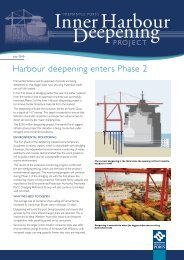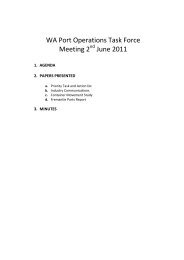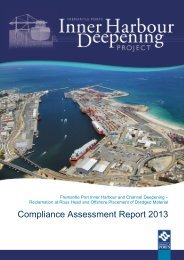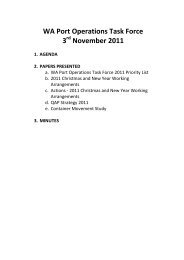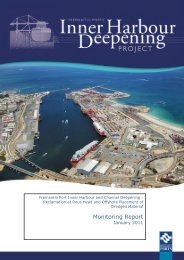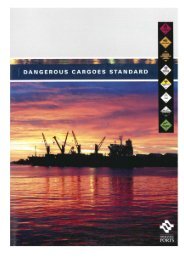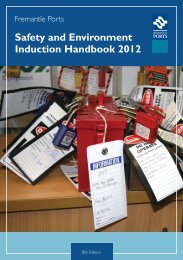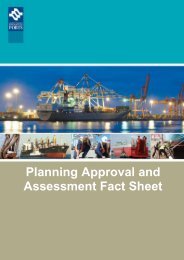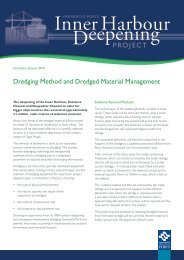Fremantle Port Inner Harbour and Channel ... - Fremantle Ports
Fremantle Port Inner Harbour and Channel ... - Fremantle Ports
Fremantle Port Inner Harbour and Channel ... - Fremantle Ports
Create successful ePaper yourself
Turn your PDF publications into a flip-book with our unique Google optimized e-Paper software.
e applied to samples (filtration etc), what analyses are to be performed <strong>and</strong> by whom, <strong>and</strong><br />
who has had custody of the samples. This information is to be completely documented on<br />
the form, <strong>and</strong> the forms must accompany the sample container(s).<br />
Chain-of-custody must be documented by everyone having responsibility for a set of<br />
samples. This should also include couriers, but should that not be possible, the courier’s<br />
signature on the waybill is sufficient.<br />
The person sending the samples should retain a copy of the form for his or her own records.<br />
When the samples reach their destination, the person receiving them must complete the<br />
form(s), keep the copy for their records <strong>and</strong> return the original with the results.<br />
7.1.5. Sample Blanks<br />
Sample blanks may be used to estimate the levels of contamination that are incurred during<br />
any stage of field sampling activities. Field blanks may be used to estimate the<br />
contamination caused by sample collection, filtering, containers, equipment <strong>and</strong> transport.<br />
When used, blanks can be particularly useful in identifying problems with specific components<br />
of the monitoring procedure, which can then be quickly rectified. The reliability of the<br />
sampling procedure (<strong>and</strong> field officer) may also be ascertained by incorporating field blanks<br />
into the monitoring programme. Further explanations on the use of different field blanks are<br />
provided by ANZECC & ARMCANZ (2000b).<br />
7.1.6. Duplicates <strong>and</strong> Replicates<br />
Duplicate samples are obtained by dividing a collected sample into two or more subsamples.<br />
Duplicates can be useful for revealing the size of errors from contamination that is occurring<br />
between sampling <strong>and</strong> sample analysis. Ideally, one duplicate should be obtained for about<br />
every 10 samples.<br />
Replicate samples are two or more samples that are collected simultaneously to establish the<br />
reproducibility of sampling. Ideally, three samples are required to enable testing of inter<strong>and</strong><br />
intra-laboratory accuracy <strong>and</strong> precision.<br />
Duplicate <strong>and</strong> replicate samples may be used as back-up samples to confirm whether a<br />
trigger has been exceeded <strong>and</strong> are particularly useful in situations when field collection is a<br />
difficult or costly exercise.<br />
7.2. Quality Assurance <strong>and</strong> Quality Control in Laboratory Procedures<br />
Only laboratories accredited with the National Association of Testing Authorities (NATA) shall<br />
be utilised to undertake sample analyses.<br />
7.2.1. Traceability of Results<br />
Apart from its chain of custody details for each sample, the laboratory must include the<br />
following information for each analysis:<br />
• Identity of sample analysed;<br />
• Identity of analyst;<br />
• Name of equipment used;<br />
• Original data <strong>and</strong> calculations;<br />
• Identification of manual data transfers;<br />
• Documentation of st<strong>and</strong>ard preparation; <strong>and</strong>,<br />
• Use of certified calibration solutions.<br />
3.4.2 Laboratory Data Reporting<br />
Laboratory reports shall be provided as part of the monitoring programme, including:<br />
• The laboratory name <strong>and</strong> address;<br />
• Tabulation of samples <strong>and</strong> analysis data;<br />
• Identification of the analytical methods used;<br />
• Limit of Reporting (LOR);<br />
• Confidence intervals of the analytical results;<br />
Oceanica: <strong>Fremantle</strong> <strong>Port</strong>s: <strong>Inner</strong> <strong>Harbour</strong> <strong>and</strong> <strong>Channel</strong> Deepening - Water Quality Monitoring Program 33



